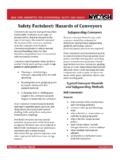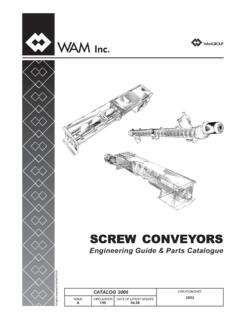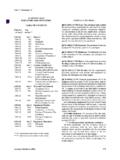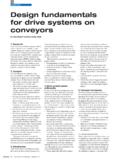Transcription of GUIDELINE Safety Around Belt Conveyors - CMASA
1 conveyor MANUFACTURERS ASSOCIATION. OF SA LIMITED. GUIDELINE . Safety Around belt Conveyors CMA MS01 Rev04/2016. Disclaimer This CMA Safety GUIDELINE was drawn up by a committee of people drawn from member companies of the conveyor Manufacturers Association of SA Ltd (CMA). The purpose of the GUIDELINE is to provide information that would enhance the safe operation and maintenance of belt conveyor systems. Many man hours were expended to gather information and document local and international practices that were considered by the committee to be safe and practical. Every effort has been made to ensure that the information provided is accurate. In all cases the applicable National legislation, local procedures, duly documented and approved risk assessments and safe working practices shall take precedence over anything else contained in this Safety GUIDELINE .
2 The CMA, its corporate members, directors, committee members or any individual associated with the generation of this Safety GUIDELINE , or any individual committee member is not responsible for any consequences, legal or financial or otherwise, arising from the use of this GUIDELINE . The entire CMA Safety GUIDELINE is applied and used solely at the discretion of the user. Safety Around belt Conveyors CMA MS01 Rev 04 - April 2016. Table of Contents 1. INTRODUCTION 3. 2. PURPOSE 3. 3. ABBREVIATIONS USED IN THIS DOCUMENT 3. 4. Safety Around belt Conveyors 3. Safety REQUIREMENTS FOR MAINTENANCE 3. STORED ENERGY 4. LOCK OUT SYSTEMS 4. PERSONNEL TRAINING IN SAFE WORKING AND OPERATING PROCEDURES 4. SAFE OPERATING PROCEDURES 5. BASIC CHECK LIST PRIOR TO RE-STARTING A conveyor 5. 5. conveyor SYSTEM PROTECTION DEVICES 5.
3 belt CONTROL 5. belt ALIGNMENT 7. belt OVERLOAD 8. belt SLIP PROTECTION 9. TAKE-UP OVER-TRAVEL 9. TRANSFER CHUTE PLUG OR BLOCKED CHUTE 10. BIN LEVEL 10. PULL-CORD STATIONS 10. RIP DETECTORS 11. FIRE DETECTION 11. 6. BASICS OF conveyor GUARD DESIGN 12. GUARDS AND FENCES 12. NIP POINTS AND NIP GUARDS 15. Definitions 15. Guarding of Nip Points 15. Nip points and associated risks 16. Nip Points at Inaccessible positions 18. Nip Guard Installation 18. MAINTENANCE AND ACCESS 21. ERGONOMICS (HUMAN - MACHINE INTERFACE). 21. Safety Around belt Conveyors CMA MS01 Rev04/2016 2. 1. INTRODUCTION. belt Conveyors are probably the most efficient means of transporting bulk materials. However, they are considered dangerous due to the sheer size of the installation which prevents clear and unimpeded visibility down the length of the system.
4 Conveyors can be one of the most hazardous mine or plant equipment installations if Safety regulations are not strictly followed or if the Conveyors are not properly maintained. The Mines Health and Safety Act (Act 4 of 1996. Section 21) states that the onus is on the supplier to provide the correct conveyor design taking into consideration the risk to the health and Safety of operating personnel. These same conditions are further extended to cover the installation of the conveying system as a whole. The Mines Health and Safety Act (Ibid. Regulation ) stipulate that all exposed machinery, that when in motion, may be dangerous to any person, must be securely fenced off or adequately guarded. Guards must be provided to such part of any machinery that may be a source of danger to any person.
5 Furthermore, the regulations (Chapter 8, Section 98 (1)) as revised in February 2008 need to be considered. See Appendix B. 2. PURPOSE. The purpose of this document is to serve as a minimum specification for the design of safe operating conditions and fulfilment of Safety requirements for belt Conveyors in accordance with the statutory regulations and Acts pertaining to machinery, particularly those sections applicable to Conveyors . 3. ABBREVIATIONS USED IN THIS DOCUMENT. MHSA Mine Health and Safety Act (Act No. 29 of 1996). PPE Personal Protection Equipment MCC Motor Control Centre CMEE Chief Mechanical and Electrical Engineer SANS South African National Standard 4. Safety Around belt Conveyors . Safety Requirements for Maintenance On a moving conveyor belt , the belt , pulleys and idlers are all in motion, and each idler, chute skirt, belt cleaner or pulley has a potential nip point, depending on its accessibility.
6 The prohibition of work on moving machinery relates to tasks such as belt cleaning, house-keeping and the removal of spillage at localised points. Where build-up of carry-back material occurs on the face of pulleys and idler shells, the removal of this build-up is only permitted when the conveyor system has stopped and been safely locked out. In instances where work needs to be carried out on the conveyor while the belt is running, such as belt training or the adjustment of material stream deflectors, it is important that this be performed by competent teams, in accordance with approved risk assessments and safe working procedures pertaining to the task being performed. While undertaking the necessary task, it is important for operators to be on the alert and to stop the conveyor by activating a pull key or an emergency stop button Safety Around belt Conveyors CMA MS01 Rev04/2016 3.
7 Which must be readily accessible. In all cases, except for those mentioned in the previous paragraph, pull keys and 3-phase isolation must be locked out and tagged prior to the commencement of any maintenance, construction or repairs. Stored Energy When maintenance is required on a conveyor system, it is important to remember the danger presented by residual energy stored within the system and to address this adequately. Thus it is necessary to isolate the stored energy from the work area or to completely release all stored energy from the system, so that work can be performed in a safe environment. This can be done by applying clamps to isolate this energy from the work area or releasing the energy applied by the take-up system. The system tensions may also be relieved by the controlled lifting of the counterweight, or the controlled pay-out of the take-up winch system.
8 Where belt clamps are utilised, these must be securely anchored to the structure. This applies to both permanent clamps and temporary belt pulling clamps. belt clamps must be inspected and tested before attachment to ensure that they are able to withstand the belt tensions in the localised area. It is vital that a competent engineer designs the belt clamps, followed by verification by a Professional Engineer. The clamps can be designed in accordance with the CMA Specification Number MC01 (2005) and other relevant, safe engineering standards. Lock out Systems When any work is carried out on the conveyor , whether to the belting, components, or to the structure, the responsible person must ensure that the system is properly locked out, following the prescribed lock out procedures, Safety regulations, Code of Practices and risk assessments.
9 Where more than one team is required to work on the conveyor , the conveyor is to be locked out for one task only at any given point in time. On completion of the task, the conveyor is unlocked. Only then can the conveyor be locked out by another team to conduct an additional task. Personnel Training in Safe Working and Operating Procedures It is mandatory that all maintenance operations have prescribed safe working procedures and policies which must be adhered to. It is important that operating staff be regularly reminded of the necessity to adhere to these safe working procedures. All new staff, whether temporary or permanent, must be formally instructed in the safe work procedures for a particular task, and records of training must be maintained. Regular training of the work force is a priority.
10 Safety Around belt Conveyors CMA MS01 Rev04/2016 4. Safe Operating Procedures Ensure that all personnel are equipped with the correct Personal Protection Equipment (PPE) relevant to the task and work area. Using PPE shall be strictly monitored by the appropriate Safety officer. Ensure that all STOP/START and emergency controls are clearly marked and that maintenance staff are familiar with the location of these Safety systems. Keep the area Around the belt clean and tidy and apply good housekeeping practices to minimise potential hazards. Lock out, isolate and tag all areas before working on any part of the conveyor . Do not climb on, over or crawl under any conveyor . Do not ride on any conveyor unless the conveyor is approved and licensed for man-riding purposes. The only actions that can be undertaken with the belt in motion are tracking of the belt and cleaning by means of high water pressure in accordance with the necessary Risk Assessment.




